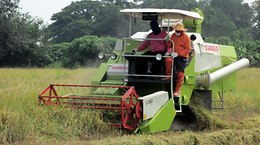
Overview

Innovation from the beginning
The company strategy has been oriented towards innovation from the very start. Company founder August Claas, who first registered the company in 1913, originally produced powerful straw binders together with his brothers Franz and Theo. An improved knotter enabled a secure knot to be tied even with the poor quality baling twine that was available at the time. The first combine harvester suitable for European harvest conditions then went into series production in 1936. Since then, the combine harvester has been inseparably linked to the CLAAS name. It is mainly this machine which has allowed CLAAS to reach its present international size and significance.
Over 11,400 employees in the group of companies around the world
Overall, the CLAAS Group has experienced an extraordinary growth phase in the last two decades. Turnover has increased from approximately €500 million at the start of the 1990s to the current level of approximately €4.8 billion (2021) and CLAAS employs over 11,900 employees around the world. The company earns more than 75 % of its revenues from international markets.
CLAAS combine harvesters, forage harvesters and large 4x4 tractors from Harsewinkel (Germany)
Around 2,300 employees work in the original CLAAS factory in Harsewinkel, which has an operational area of 400,000 m2. Of the four assembly lines in the Harsewinkel plant, one produces the LEXION 780-740 and 670-620 large combine harvester series, which consists of more than 50,000 components; another is dedicated to the TUCANO 570-320, AVERO 240/160 and DOMINATOR 40 combine harvester ranges. The two remaining assembly lines are for the JAGUAR 980-930 and 870-840 forage harvester series and the XERION 5000-4000 large 4x4 tractors, which have engine outputs of up to 530 hp. From Harsewinkel, machines are sent all over the world by both road and rail.
CLAAS forage harvest machines from Bad Salgau (Germany)
In its plant in the town of Bad Saulgau in Upper Swabia within the largest contiguous grassland region in Europe, 550 CLAAS employees manufacture the company’s entire forage machinery range: DISCO disc mowers, VOLTO tedders, LINER swathers and CARGOS combi and chopper transport wagons. In addition, the chopper unit and a wide-range of attachments for the JAGUAR forage harvester are manufactured. The factory also contains one of the most modern product development centres in the world. For example, the centrepiece of the DISCO, the MAX CUT mower bar, was born there. In addition, a completely new test and reference track was built in 2017 for prototyping.
Electronics Development Centre in Dissen (Germany)
CLAAS has invested a multi-million sum in the new CLAAS E Systems site in Dissen, Lower Saxony. Back in 1998, CLAAS acquired one of the leading agricultural software companies and successfully integrated it into the Group. Since then, a powerful range of technologies designed to increase efficiency has emerged under the brand name EASY. CLAAS has become one of the leading suppliers of precision farming solutions, and has won numerous awards for its innovations.
CLAAS Industrietechnik (CIT) from Paderborn (Germany)
CIT is the leading systems supplier for drivetrain technology and hydraulics in the CLAAS Group. Over 600 staff at the Paderborn site develop and produce customer and sector-specific solutions. The innovative system solutions are used in agricultural technology, municipal services, construction machinery and diverse industrial applications. CIT also supplies them to major OEMs outside of the CLAAS Group all over the world. Probably its most famous product is the TERRA TRAC roller unit for the CLAAS LEXION combine harvester, which will be fitted to the JAGUAR forage harvester this year, and also to the AXION 900 tractor in approximately two years’ time. Since 2013, CIT’s range has boasted an infinitely variable transmission for tractors, developed in-house.
CLAAS Parts Logistics Center in Hamm (Germany)
The CLAAS Parts Logistics Center has been located in the Uentrop district of the city of Hamm, ideally situated for access to the motorway, since 2000. The 585 employees there send out spare parts to more than 100 countries. Spread out over the 116,525 m2 warehouse area of the Logistics Center are some 198,000 different parts, all ready for shipping. In almost all cases, the orders reach their destination within 24 hours (service level of 97%).
CLAAS tractors from Le Mans (France)
In 2003, the CLAAS Group made a major leap forwards in terms of growth by taking over the majority of French tractor manufacturer Renault Agriculture. Today, CLAAS has an extensive range of modern tractors in its sales programme. The company has since grown by over €600 million in turnover and around 2,000 staff. The takeover of Renault Agriculture was completed in 2008. The employees in France now make up more than a quarter of the CLAAS workforce. The AXION 950-920, AXION 870-800, ARION 650-530, ARION 460-410 and ATOS 350-220 tractor series, which between them cover a performance spectrum from 72 to 410 HP, are currently all produced in Le Mans.
CLAAS balers from Metz (France)
The 400 staff in the CLAAS factory in Metz, which has traded under the name Usines CLAAS France S.A., or UCF, since 1969, manufacture balers for agriculture. The programme includes the QUADRANT square baler series and the ROLLANT and VARIANT round baler series. The largest investment in recent years has been the painting system, which was commissioned in 2013. It boasts CO2 neutral status and low energy consumption and sets a new standard in quality and sustainability. Thanks to the mix assembly, usines CLAAS France is able to produce every type of press every day.
Cutterbars for combines from Törökszentmiklós (Hungary)
CLAAS took over the plant for agricultural machinery manufacturing in Törökszentmiklós in 1997. Since then the plant has become the R&D and production center of cutterbars and trailers for combines of the whole Group. 700 people are employed in Törökszentmiklós.
LEXION combine harvesters from Nebraska (USA)
In the late 1990s, a new combine harvester factory was built in Omaha in the US state of Nebraska. On an area that was once farmland near the Missouri River, CLAAS developed a production site for the LEXION combine harvester. The plant is in the middle of the largest grain farming region in the USA. The LEXION combine harvesters are sold throughout the North American market.
CLAAS combine harvesters from Faridabad and Chandigarh (India)
The track roller and tyre versions of the CROP TIGER 30 have been rolling off the production line in Faridabad, near the Indian capital New Delhi, since 1995. In 2008, CLAAS also built a new factory in the northern Indian state of Punjab. The plant in Morinda, near Chandigarh, mainly produces CROP TIGER 60 combine harvesters. The machines manufactured in Chandigarh are sold not only in the Indian market but also in South Korea, Thailand and Africa.
CLAAS harvest machines from Gaomi (China)
In January 2014, CLAAS successfully completed its takeover of the Chinese agricultural machinery manufacturer Shandong Jinyee Machinery Manufacture Co. Ltd (Jinyee) in the city of Gaomi, Shangdong province. Since January 2017, the company has been operating with around 1,000 employees as a wholly-owned CLAAS subsidiary under the name of CLAAS Agricultural Machinery (Shandong) Co. Ltd. The site in Gaomi covers the entire value chain of the products produced there, mainly for maize and wheat harvesting. Teams from Research and Development, Engineering, Production and Sales, Service and Spare Parts continually develop products for the Chinese brand, CHUNYU, supplying around 200 CHUNYU dealers. The CLAAS MARKANT baler is also manufactured in a dedicated production area at the site.
CLAAS combine harvesters and tractors from Krasnodar (southern Russia)
In 2005, CLAAS was the first western agricultural machinery producer present in Russia with its own factory. The plant in Krasnodar was significantly extended in 2015, with CLAAS investing around 120 million euros in it. The new production area is around nine times larger than the previous factory and covers around 45,000 square metres. This has increased the production volume to 2,500 combine harvesters and tractors per year. Thanks to a special investment contract that was signed in June 2016, CLAAS has now been given official status as a “Russian manufacturer” and receives the same state financial support for its combine harvesters as local producers.




















